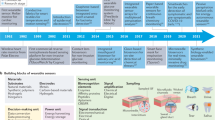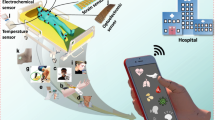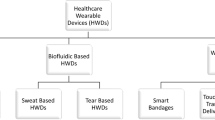Abstract
Wearable bioelectronic sensors are often used for health monitoring but are typically limited to a few physical or chemical parameters, which hinders their ability to provide a complete health assessment. Recently, wearable sensor platforms have been developed that can simultaneously and continuously record multiple biophysical and biochemical signals. These devices take advantage of advances in electronic device fabrication and miniaturization, bioelectronic sensors, and flexible materials. However, compared with existing wearable systems, which mostly contain either biochemical or biophysical sensors, hybrid multimodal wearable patches present a number of distinct challenges for further advancement. Here, we examine the development of such hybrid multimodal wearable sensors and explore their potential applications in tracking the health and disease status of different users. We highlight the key biomarkers and vital signs (related to various pathophysiological conditions) that hybrid bioelectronic sensor systems must be designed around. We also explore how artificial intelligence could be integrated with these hybrid multimodal sensors to offer wearers the ability to assess their health status in real time.
This is a preview of subscription content, access via your institution
Access options
Access Nature and 54 other Nature Portfolio journals
Get Nature+, our best-value online-access subscription
$29.99 / 30 days
cancel any time
Subscribe to this journal
Receive 12 digital issues and online access to articles
$119.00 per year
only $9.92 per issue
Buy this article
- Purchase on SpringerLink
- Instant access to full article PDF
Prices may be subject to local taxes which are calculated during checkout





Similar content being viewed by others
References
Wilson, T., Holt, T. & Greenhalgh, T. Complexity science: complexity and clinical care. BMJ 323, 685–688 (2001).
Chen, C., Ding, S. & Wang, J. Digital health for aging populations. Nat. Med. 29, 1623–1630 (2023).
Kim, J., Campbell, A. S., de Ávila, B. E. F. & Wang, J. Wearable biosensors for healthcare monitoring. Nat. Biotechnol. 37, 389–406 (2019).
Ricotti, V. et al. Wearable full-body motion tracking of activities of daily living predicts disease trajectory in Duchenne muscular dystrophy. Nat. Med. 29, 95–103 (2023).
Sempionatto, J. R., Lasalde-Ramírez, J. A., Mahato, K., Wang, J. & Gao, W. Wearable chemical sensors for biomarker discovery in the omics era. Nat. Rev. Chem. 6, 899–915 (2022).
Xu, S., Kim, J., Walter, J. R., Ghaffari, R. & Rogers, J. A. Translational gaps and opportunities for medical wearables in digital health. Sci. Transl. Med. 14, eabn6036 (2023).
Ates, H. C. et al. End-to-end design of wearable sensors. Nat. Rev. Mater. 7, 887–907 (2022).
Quer, G. et al. Wearable sensor data and self-reported symptoms for COVID-19 detection. Nat. Med. 27, 73–77 (2021).
King, R. C. et al. Application of data fusion techniques and technologies for wearable health monitoring. Med. Eng. Phys. 42, 1–12 (2017).
Muzammal, M., Talat, R., Sodhro, A. H. & Pirbhulal, S. A multi-sensor data fusion enabled ensemble approach for medical data from body sensor networks. Inf. Fusion 53, 155–164 (2020).
Vargas, E., Nandhakumar, P., Ding, S., Saha, T. & Wang, J. Insulin detection in diabetes mellitus: challenges and new prospects. Nat. Rev. Endocrinol. 19, 487–495 (2023).
Saha, T. et al. Wearable electrochemical glucose sensors in diabetes 2 management: a comprehensive review. Chem. Rev. 123, 7854–7889 (2023).
Teymourian, H., Barfidokht, A. & Wang, J. Electrochemical glucose sensors in diabetes management: an updated review (2010–2020). Chem. Soc. Rev. 49, 7671–7709 (2020).
Almalki, Z. S. et al. Prevalence, risk factors, and management of uncontrolled hypertension among patients with diabetes: a hospital-based cross-sectional study. Prim. Care Diabetes 14, 610–615 (2020).
Mancia, G. & Parati, G. The role of blood pressure variability in end-organ damage. J. Hypertens. 21, S17–S23 (2003).
Gao, W., Ota, H., Kiriya, D., Takei, K. & Javey, A. Flexible electronics toward wearable sensing. Acc. Chem. Res. 52, 523–533 (2019).
Ray, T. R. et al. Bio-integrated wearable systems: a comprehensive review. Chem. Rev. 119, 5461–5533 (2019).
Hozumi, S., Honda, S., Arie, T., Akita, S. & Takei, K. Multimodal wearable sensor sheet for health-related chemical and physical monitoring. ACS Sens. 6, 1918–1924 (2021).
Teymourian, H. et al. Closing the loop for patients with Parkinson disease: where are we? Nat. Rev. Neurol. 2022 188 18, 497–507 (2022).
Xu, Y. et al. In-ear integrated sensor array for the continuous monitoring of brain activity and of lactate in sweat. Nat. Biomed. Eng. 7, 1307–1320 (2023).
Teymourian, H., Tehrani, F., Mahato, K. & Wang, J. Lab under the skin: microneedle based wearable devices. Adv. Healthc. Mater. 10, 2002255 (2021).
Choi, J.-Y. et al. Health-related indicators measured using earable devices: systematic review. JMIR mHealth uHealth 10, e36696 (2022).
Sempionatto, J. R. et al. Eyeglasses based wireless electrolyte and metabolite sensor platform. Lab Chip 17, 1834–1842 (2017).
Gao, W. et al. Fully integrated wearable sensor arrays for multiplexed in situ perspiration analysis. Nature 529, 509–514 (2016).
Mishra, R. K. et al. Simultaneous detection of salivary Δ9-tetrahydrocannabinol and alcohol using a wearable electrochemical ring sensor. Talanta 211, 120757 (2020).
Zeng, K., Shi, X., Tang, C., Liu, T. & Peng, H. Design, fabrication and assembly considerations for electronic systems made of fibre devices. Nat. Rev. Mater. 8, 552–561 (2023).
Chen, G. et al. Electronic textiles for wearable point-of-care systems. Chem. Rev. 122, 3259–3291 (2021).
Tehrani, F. et al. An integrated wearable microneedle array for the continuous monitoring of multiple biomarkers in interstitial fluid. Nat. Biomed. Eng. 6, 1214–1224 (2022).
Min, J. et al. An autonomous wearable biosensor powered by a perovskite solar cell. Nat. Electron. 6, 630–641 (2023).
Salahuddin, S., Ni, K. & Datta, S. The era of hyper-scaling in electronics. Nat. Electron. 1, 442–450 (2018).
Yin, L., Lv, J. & Wang, J. Structural innovations in printed, flexible, and stretchable electronics. Adv. Mater. Technol. 5, 2000694 (2020).
Fujiwara, H. et al. Enhancing the performance of stretchable conductors for e-textiles by controlled ink permeation. Adv. Mater. 29, 1605848 (2017).
Kim, D.-H. et al. Epidermal electronics. Science 333, 838–843 (2011).
Wang, C. et al. Monitoring of the central blood pressure waveform via a conformal ultrasonic device. Nat. Biomed. Eng. 2, 687–695 (2018).
Yin, L. et al. From all‐printed 2D patterns to free‐standing 3D structures: controlled buckling and selective bonding. Adv. Mater. Technol. 3, 1800013 (2018).
Tehrani, F. et al. Laser-induced graphene composites for printed, stretchable, and wearable electronics. Adv. Mater. Technol. 4, 1900162 (2019).
Huang, Z. et al. Three-dimensional integrated stretchable electronics. Nat. Electron. 1, 473–480 (2018).
Luo, Y. et al. Technology roadmap for flexible sensors. ACS Nano 17, 5211–5295 (2023).
Forkan, A. R. M., Forkan, A. R. M., Khalil, I. & Atiquzzaman, M. ViSiBiD: a learning model for early discovery and real-time prediction of severe clinical events using vital signs as big data. Comput. Netw. 113, 244–257 (2017).
Jin, X., Liu, C., Xu, T., Su, L. & Zhang, X. Artificial intelligence biosensors: challenges and prospects. Biosens. Bioelectron. 165, 112412 (2020).
Cao, R., Tang, Z., Liu, C. & Veeravalli, B. A scalable multicloud storage architecture for cloud-supported medical Internet of Things. IEEE Internet Things J. 7, 1641–1654 (2020).
Shan, G., Li, X., Huang, W., Huang, W. & Huang, W. AI-enabled wearable and flexible electronics for assessing full personal exposures. Innov. Eur. J. Soc. Sci. Res. 1, 100031 (2020).
Xu, C. et al. A physicochemical-sensing electronic skin for stress response monitoring. Nat. Electron. 7, 168–179 (2024).
Huang, J.-D. et al. Applying artificial intelligence to wearable sensor data to diagnose and predict cardiovascular disease: a review. Sensors 22, 8002 (2022).
Sitaula, C. et al. Artificial intelligence-driven wearable technologies for neonatal cardiorespiratory monitoring. Part 2: artificial intelligence. Pediatr. Res. 93, 426–436 (2023).
Grooby, E. et al. Artificial intelligence-driven wearable technologies for neonatal cardiorespiratory monitoring. Part 1 wearable technology. Pediatr. Res. 93, 413–425 (2023).
Xie, Y. et al. Integration of artificial intelligence, blockchain, and wearable technology for chronic disease management: a new paradigm in smart healthcare. Curr. Med. Sci. 41, 1123–1133 (2021).
Tsafaras, G. P., Ntontsi, P. & Xanthou, G. Advantages and limitations of the neonatal immune system. Front. Pediatr. 8, 5 (2020).
Chung, H. U. et al. Binodal, wireless epidermal electronic systems with in-sensor analytics for neonatal intensive care. Science 363, eaau0780 (2019).
Milton, R. et al. Neonatal sepsis and mortality in low-income and middle-income countries from a facility-based birth cohort: an international multisite prospective observational study. Lancet Glob. Health 10, e661–e672 (2022).
Shane, A. L., Sánchez, P. J. & Stoll, B. J. Neonatal sepsis. Lancet 390, 1770–1780 (2017).
Pan, D. H. & Rivas, Y. Jaundice: newborn to age 2 months. Pediatr. Rev. 38, 499–510 (2017).
Olusanya, B. O., Kaplan, M. & Hansen, T. W. R. Neonatal hyperbilirubinaemia: a global perspective. Lancet Child Adolesc. Health 2, 610–620 (2018).
Inamori, G. et al. Neonatal wearable device for colorimetry-based real-time detection of jaundice with simultaneous sensing of vitals. Sci. Adv. 7, eabe3793 (2021).
Jayanthi, N. et al. Risk of injuries associated with sport specialization and intense training patterns in young athletes: a longitudinal clinical case-control study. Orthop. J. Sport. Med. 8, 2325967120922764 (2020).
Raghuveer, G. et al. Cardiorespiratory fitness in youth: an important marker of health: a scientific statement from the American Heart Association. Circulation 142, e101–e118 (2020).
Lee, H. & Thap, T. A wearable watch-type reflectance-based blood-oxygen saturation (SpO2) level estimation. In Proc. Korea Information Processing Society Conference 578–579 (Korea Information Processing Society, 2015).
Tipton, M. J., Harper, A., Paton, J. F. R. & Costello, J. T. The human ventilatory response to stress: rate or depth? J. Physiol. 595, 5729–5752 (2017).
Gleeson, M. Biochemical and immunological markers of overtraining. J. Sport. Sci. Med. 1, 31–41 (2002).
Löffler, M. et al. Stress-induced hyperalgesia instead of analgesia in patients with chronic musculoskeletal pain. Neurobiol. Pain. 13, 100110 (2023).
Kellezi, B. et al. The impact of psychological factors on recovery from injury: a multicentre cohort study. Soc. Psychiatry Psychiatr. Epidemiol. 52, 855–866 (2017).
Gaidai, O., Cao, Y. & Loginov, S. Global cardiovascular diseases death rate prediction. Curr. Probl. Cardiol. 48, 101622 (2023).
Xintarakou, A., Sousonis, V., Asvestas, D., Vardas, P. E. & Tzeis, S. Remote cardiac rhythm monitoring in the era of smart wearables: present assets and future perspectives. Front. Cardiovasc. Med. 5, 853614 (2022).
Rizas, K. D. et al. Smartphone-based screening for atrial fibrillation: a pragmatic randomized clinical trial. Nat. Med. 28, 1823–1830 (2022).
Rudd, K. E. et al. Global, regional, and national sepsis incidence and mortality, 1990-2017: analysis for the Global Burden of Disease Study. Lancet 395, 200–211 (2020).
Kenzaka, T. et al. Importance of vital signs to the early diagnosis and severity of sepsis: association between vital signs and sequential organ failure assessment score in patients with sepsis. Intern. Med. 51, 871–876 (2012).
Levey, A. S. & Coresh, J. Chronic kidney disease. Lancet 379, 165–180 (2012).
Kukkar, D., Zhang, D., Jeon, B. H., Yoshimura, M. & Kim, K.-H. Recent advances in wearable biosensors for non-invasive monitoring of specific metabolites and electrolytes associated with chronic kidney disease: performance evaluation and future challenges. Trends Anal. Chem. 150, 116570 (2022).
Hou, Y. et al. Ageing as a risk factor for neurodegenerative disease. Nat. Rev. Neurol. 15, 565–581 (2019).
Kuusik, A., Alam, M. M., Kask, T. & Gross-Paju, K. Wearable m-assessment system for neurological disease patients. In 2018 IEEE 4th World Forum on Internet of Things (WF-IoT) 201–206 (IEEE, 2018); https://doi.org/10.1109/WF-IoT.2018.8355165
Imani, S. et al. A wearable chemical–electrophysiological hybrid biosensing system for real-time health and fitness monitoring. Nat. Commun. 7, 11650 (2016).
Sempionatto, J. R. et al. An epidermal patch for the simultaneous monitoring of haemodynamic and metabolic biomarkers. Nat. Biomed. Eng. 5, 737–748 (2021).
Shirzaei Sani, E. et al. A stretchable wireless wearable bioelectronic system for multiplexed monitoring and combination treatment of infected chronic wounds. Sci. Adv. 9, eadf7388 (2023).
Hong, Y. J. et al. Multifunctional wearable system that integrates sweat-based sensing and vital-sign monitoring to estimate pre-/post-exercise glucose levels. Adv. Funct. Mater. 28, 1805754 (2018).
Li, T. et al. An integrated and conductive hydrogel-paper patch for simultaneous sensing of chemical–electrophysiological signals. Biosens. Bioelectron. 198, 113855 (2022).
Lee, H. et al. Wearable/disposable sweat-based glucose monitoring device with multistage transdermal drug delivery module. Sci. Adv. 3, e1601314 (2017).
Zahed, M. A. et al. Microfluidic-integrated multimodal wearable hybrid patch for wireless and continuous physiological monitoring. ACS Sens. 8, 2960–2974 (2023).
Yokus, M. A., Songkakul, T., Pozdin, V. A., Bozkurt, A. & Daniele, M. A. Wearable multiplexed biosensor system toward continuous monitoring of metabolites. Biosens. Bioelectron. 153, 112038 (2020).
Hu, H. et al. A wearable cardiac ultrasound imager. Nature 613, 667–675 (2023).
Yin, L. et al. Highly stable battery pack via insulated, reinforced, buckling-enabled interconnect array. Small 14, 1800938 (2018).
Yin, L., Kim, K. N., Trifonov, A., Podhajny, T. & Wang, J. Designing wearable microgrids: towards autonomous sustainable on-body energy management. Energy Environ. Sci. 15, 82–101 (2022).
Winokur, E. S., Delano, M. K. & Sodini, C. G. A wearable cardiac monitor for long-term data acquisition and analysis. IEEE Trans. Biomed. Eng. 60, 189–192 (2013).
Gong, X. et al. High-performance non-enzymatic glucose sensors based on CoNiCu alloy nanotubes arrays prepared by electrodeposition. Front. Mater. 6, 3 (2019).
Sivarajah, U., Kamal, M. M., Irani, Z. & Weerakkody, V. Critical analysis of big data challenges and analytical methods. J. Bus. Res. 70, 263–286 (2017).
Ngiam, K. Y., Ngiam, K. Y. & Khor, I. W. Big data and machine learning algorithms for health-care delivery. Lancet Oncol. 20, e262–e273 (2019).
Mohindru, G., Mondal, K. & Banka, H. Internet of Things and data analytics: a current review. WIREs Data Min. Knowl. Discov. 10, e1341 (2020).
Lee, H., Park, K., Lee, B., Choi, J. & Elmasri, R. Issues in data fusion for healthcare monitoring. In Proc. 1st International Conference on Pervasive Technologies Related to Assistive Environments 1–8 (ACM, 2008); https://doi.org/10.1145/1389586.1389590
Stahlschmidt, S. R., Ulfenborg, B. & Synnergren, J. Multimodal deep learning for biomedical data fusion: a review. Brief. Bioinform. 23, bbab569 (2022).
Tyler, J., Choi, S. W. & Tewari, M. Real-time, personalized medicine through wearable sensors and dynamic predictive modeling: a new paradigm for clinical medicine. Curr. Opin. Syst. Biol. 20, 17–25 (2020).
Pong, M. H., Wu, X., Lee, C. M. & Qian, Z. Reduction of crosstalk on printed circuit board using genetic algorithm in switching power supply. IEEE Trans. Ind. Electron. 48, 235–238 (2001).
Heikenfeld, J. et al. Wearable sensors: modalities, challenges, and prospects. Lab Chip 18, 217–248 (2018).
Lu, L. et al. Wearable health devices in health care: narrative systematic review. JMIR mHealth uHealth 8, e18907 (2020).
Saha, T., Del Caño, R., la De Paz, E., Sandhu, S. S. & Wang, J. Access and management of sweat for non‐invasive biomarker monitoring: a comprehensive review. Small 19, 2206064 (2022).
Yu, Y. et al. Biofuel-powered soft electronic skin with multiplexed and wireless sensing for human-machine interfaces. Sci. Robot. 5, eaaz7946 (2020).
Yin, L. et al. Wearable e‐skin microgrid with battery‐based, self‐regulated bioenergy module for epidermal sweat sensing. Adv. Energy Mater. 13, 2203418 (2022).
Yin, L. et al. A stretchable epidermal sweat sensing platform with an integrated printed battery and electrochromic display. Nat. Electron. 5, 694–705 (2022).
Dassanayaka, D. G., Alves, T. M., Wanasekara, N. D., Dharmasena, I. G. & Ventura, J. Recent progresses in wearable triboelectric nanogenerators. Adv. Funct. Mater. 32, 2205438 (2022).
Liaw, D.-J. et al. Advanced polyimide materials: syntheses, physical properties and applications. Prog. Polym. Sci. 37, 907–974 (2012).
Yin, L. et al. A self-sustainable wearable multi-modular e-textile bioenergy microgrid system. Nat. Commun. 12, 1542 (2020).
Cui, F., Yue, Y., Zhang, Y., Zhang, Z. & Zhou, H. S. Advancing biosensors with machine learning. ACS Sens. 5, 3346–3364 (2020).
Witt, D. R. et al. Windows into human health through wearables data analytics. Curr. Opin. Biomed. Eng. 9, 28–46 (2019).
Hwang, D.-K. et al. Smartphone-based diabetic macula edema screening with an offline artificial intelligence. J. Chin. Med. Assoc. 83, 1102–1106 (2020).
Baker, L. B. et al. Skin-interfaced microfluidic system with personalized sweating rate and sweat chloride analytics for sports science applications. Sci. Adv. 6, eabe3929 (2020).
Chung, H. U. et al. Skin-interfaced biosensors for advanced wireless physiological monitoring in neonatal and pediatric intensive-care units. Nat. Med. 26, 418–429 (2020).
List of Fitbit products. Wikipedia https://en.wikipedia.org/wiki/List_of_Fitbit_products#Fitbit_Ultra (2016).
Acknowledgements
We acknowledge the support of the Center for Wearable Sensors, University of California, San Diego for this work.
Author information
Authors and Affiliations
Contributions
K.M. and J.W. conceived the idea of the paper. K.M. performed the literature analysis and collected data. K.M., T.S., S.D., S.S.S., A.-Y.C. and J.W. discussed, wrote and commented on the paper. J.W. supervised the work.
Corresponding author
Ethics declarations
Competing interests
The authors declare no competing interests.
Peer review
Peer review information
Nature Electronics thanks Sen Lin and the other, anonymous, reviewer(s) for their contribution to the peer review of this work.
Additional information
Publisher’s note Springer Nature remains neutral with regard to jurisdictional claims in published maps and institutional affiliations.
Rights and permissions
Springer Nature or its licensor (e.g. a society or other partner) holds exclusive rights to this article under a publishing agreement with the author(s) or other rightsholder(s); author self-archiving of the accepted manuscript version of this article is solely governed by the terms of such publishing agreement and applicable law.
About this article
Cite this article
Mahato, K., Saha, T., Ding, S. et al. Hybrid multimodal wearable sensors for comprehensive health monitoring. Nat Electron 7, 735–750 (2024). https://doi.org/10.1038/s41928-024-01247-4
Received:
Accepted:
Published:
Issue Date:
DOI: https://doi.org/10.1038/s41928-024-01247-4



